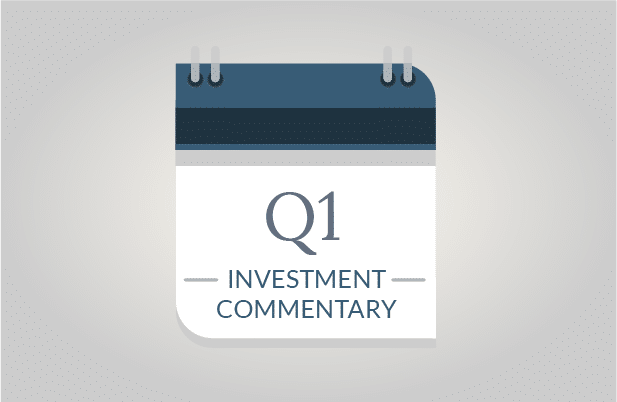SageVest Wealth Management’s quarterly commentary is now available, reviewing the first quarter of 2018. Highlights include:
– Market volatility unleashed in the first quarter.
– Fears of inflation, trade wars and the outlook for key stock market leaders choked the markets.
– Investors are cautioned to think long-term about appropriate positioning after volatile market swings.
A Volatile Start To The Year
The stock markets started 2018 on a rollercoaster ride. Virtually every major market index, including stocks and bonds, posted negative returns as of March 31st. Fortunately, quarter-end losses were fairly modest, despite rapid and volatile swings, including more than 10% correction from stock market highs. An incredibly strong start to the year in stocks elevated prices before the correction commenced, helping to soften the year-to-date impact for investors.
After 2017, a year marked by virtual daily ascent among global stock markets, the start of 2018 proved to be a bold reminder of the presence of risk. Fears about inflation and trade wars prompted a strong sell-off in early February. The tech sector darling of 2017 felt some of the greatest downturns, particularly the beloved FANG (Facebook, Apple, Amazon, Netflix and Google) stocks. Facebook’s user data infringement debacle further tarnished the tech sector, particularly given discussions and actions to impose stronger regulation that could infringe upon the sector’s growth potential.
Fortunately, dramatic market upswings also occurred in the first quarter, leaving investors quizzical as to what will follow in 2018. We strongly advise all readers to carefully consider risk and long-term investment objectives, relative to investment positioning. We also strongly recommend disciplined rebalancing, which benefited our clients as we trimmed equities in mid-January, shortly before the market sell-off.
A Healthy Economy
Before we address key topics that impacted the markets, we feel it’s important to start by reminding investors that the overall health of the economy remains strong. In fact, the magnitude of the economy’s strength is ironically one of the reasons that prompted a stock market pullback. A hot job market (and corresponding low unemployment) is fueling concerns about inflation, namely wage growth. While this is a valid concern, it should also be taken with a grain of salt post almost a decade of economists and central bankers fretting about deflation.
Our economic growth engine is humming, with U.S. Gross Domestic Product (GDP) growth projected in the range of 2.5% (+/-). This is finally trending toward the growth we need after years of anemic growth. Furthermore, despite an uptick in inflation, it still remains in check and below the key 2% threshold. In our view, we much prefer combatting modest inflation versus years of fighting stagnation.
Inflation And Bonds
Renewed inflation fears pushed bond yields higher, and corresponding bond prices lower, during the first quarter. A strong job market, coupled with a Federal Reserve Board (FED) focused on curbing inflation by raising borrowing rates, buoyed 10-year Treasury yields higher. The 10-year Treasury yield began the year at 2.4%, went as high as 2.94% in late February, and retreated back to 2.74% by the quarter-end.
While bond yields and corresponding borrowing costs have risen, the 10-year Treasury yield remains well below its historical average of roughly 4%. We are by no means in an ultra-high interest rate environment. Yet, bond scaremongers were quick to holler get out of bonds as rates were increasing. We find it important to remind investors of why they own bonds.
First and foremost, bonds are designed to protect your portfolio during market downturns. Interestingly, there was a flight to safety in Treasuries (pushing bond prices back higher) as equity markets tumbled.
Second, bonds are held to secure liquidity for withdrawal needs, particularly if you’re retired or approaching retirement, so you don’t have to sell stocks when markets correct, as they inevitably do.
Third, bonds provide buying power when stocks retreat, allowing you to be a smart investor and buy when stock prices are lower.
We find it interesting to note that while the Aggregate Bond Index was down about 3% at its worst point during the first quarter, we saw the stock markets feel this kind of move in one single day. Bottom line: the inherent risk in investment grade bonds pales in comparison to stocks, even with the notion of possible inflation on the horizon.
One important cautionary note is to evaluate the quality of the bonds you own. Lower quality bonds provide greater income potential, but they also beget greater risk potential. Over the past year, we’ve focused on increasing the quality of our bond portfolio. We advise all readers to carefully evaluate the quality of the bonds they’re holding.
Global Trade Wars
A significant detractor to first quarter performance was the emergence of trade wars. Fortunately, the risks of a potential conflict with North Korea dissipated as diplomatic efforts hinted at upcoming political discussions. However, broader trade talks waged on the global horizon.
President Trump threatened trade wars during his campaign. While he steered clear of significant trade matters during his first year in office, he recently unleashed a fury of threats and actions, notably aimed at China.
Initial trade tensions with China were thought to have subsided when bilateral discussions appeared to be emerging. However, subsequent actions by China to levy tariffs on 128 categories of American goods renewed concerns of deteriorating trade relations, further detracting from stock performance as the second quarter commenced.
Trade wars are tricky and can prove dangerous, particularly for given industries that get caught in the middle of international trade games. In an effort to protect America’s interest in aluminum and steel trade, we could see the onset of decreased demand for US goods sold abroad and/or increased costs for imported goods. Both present potential risks.
Technology Lust
Finally, the technology sector is an area worthy of watching. It’s certainly the path of the future. However, just like the late ‘90s technology feast and famine, technology stock performance can come in waves. We might have seen the crest of the recent technology wave, or perhaps it moves higher. Regardless, technology stocks are under scrutiny, from both regulatory bodies and the public at large.
Without going into the details of company specifics, we think it’s important to note that the FANG stocks have risen so far in value that this handful of stocks represents more than 10% of the total of all 500 companies in the S&P 500 index. Dramatic growth in recent years has benefited stock owners, but has also increased risk potential, as a downfall in just one of these stocks could significantly bruise the markets.
Looking Ahead
As we look ahead, we’re cautiously optimistic as the economy remains strong, while recognizing the markets are due for a correction, particularly with lofty stock valuations. We adamantly believe this is a time to hold an all-weather investment portfolio. Don’t be a bond scaremonger, as high-quality bonds offer the protection and flexibility you need during a downturn. Likewise, don’t run from stocks because of short-term volatility. Stocks are ultimately how to grow your portfolio and outpace inflation. Finding the right balance of the two is the most important investment decision. Furthermore, maintaining discipline in your strategy is the most important investment action.
SageVest Wealth Management




